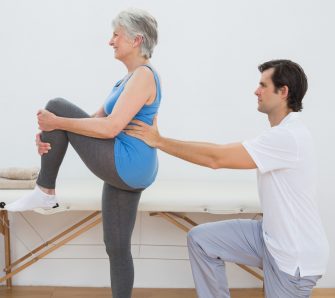LBP and Poor Balance Lead to More Falls for Older Adults
 According to the Centers for Disease Control and Prevention (CDC), 3 million older people are treated in emergency departments for fall injuries each year. They estimate that 20% of falls result in a serious injury such as broken bones or head injury.
According to the Centers for Disease Control and Prevention (CDC), 3 million older people are treated in emergency departments for fall injuries each year. They estimate that 20% of falls result in a serious injury such as broken bones or head injury.
The medical costs for post-fall treatment was over $50 billion in 2015, with 75% of that being covered by Medicare or Medicaid. The fall death rate of older adults increased 30% from 2007 to 2016. If this trend continues, the death rate may be as high as 7 every hour by 2030.
As the general population ages, it is important to evaluate how we can help older adults stay healthy and strong in order to prevent falls from occurring.
Low back pain (LBP) is a common complaint among older adults and has been linked to an increased fall risk. According to the CDC, those with low back pain complaints reported having three times as much difficulty performing activities of daily living. Additionally, the fall rate for that same group was twice as high.
In a 2013 study published in the European Spine Journal, researchers found that the thoracic/lumbar angle ratio, lumbar lordosis angle, sacral inclination angle, grip strength, back muscle strength, 10-m gait time, and height of the intervertebral disc were significantly different between subjects who had, and had not, fallen over the previous year.
It is common for patients experiencing pain to develop a fear of movement, or “kinesiophobia,” as a way to cope. This can have negative impact on muscular stabilization, normal posture and balance patterns.
Proprioception is the brain’s awareness of the body – where it is in space. When the brain is not able to receive proper feedback from the body, this can diminish or alter the person’s proprioceptive ability. If this pattern continues, the patients’ body adopts the altered movements as normal resulting in:
- reduced balance
- reduced motor behavior and sensory feedback
- difficulty in adapting to sudden surface changes
- decreased muscle control (both for positioning and movement)
- delays in movement initiation
Low back pain is just one risk factor for falls. When you see a chiropractor for low back pain, don’t be surprised if you are asked about vitamins, medications (including over the counter), vision difficulties, foot pain or obstacles in your home. The CDC lists all of these as fall risk factors. Because most falls are not attributed to a single cause, but instead a combination of factors, having multiple risk factors can mean a person is more likely to fall.
Along with treating the cause of the low back pain, chiropractors can address many of these other factors as well. As experts in the musculoskeletal system, they can help identify spinal misalignments, as well as balance and muscle control issues. If a deficiency is detected, they can work with the patient to help the body return to more normal and balanced patterns. The specific treatment plan will be customized to the individual and their condition and may include:
- spinal adjustment,
- therapeutic modalities,
- specific exercises,
- discussion of potential risks at home (bed and toilet height, proper lighting, etc),
- a review of resources available,
- and in some cases, may involve a referral to another health care provider for additional treatment.
A medical physician may need to review medications. An occupational therapist may be able to make a home visit to assist with trip hazards and making the home safer by recommending hand rails, etc. For some patients, a medic alert device may be considered.
They say the best offense is a good defense. Learn to defend yourself against falls. If you or a loved one is experiencing low back pain, especially if you are over 60, discuss fall risk factors with your chiropractor at your next visit. Determine what preventative steps you can take to minimize your fall risk and keep moving.
REFERENCES:
“Important Facts about Falls” https://www.cdc.gov/homeandrecreationalsafety/falls/adultfalls.html
Hosenfeld,C, DC, CCSP, Stevens, T, CTA, Chiropractic Therapy Assistant: A Clinical Resource Guide “Chapter 8: Spinal Rehabilitation Fundamentals”
Imagama S, Ito Z, Wakao N, Seki T, Hirano K, Muramoto A, Sakai Y, Matsuyama Y, Hamajima N, Ishiguro N, Hasegawa Y. “Influence of spinal sagittal alignment, body balance, muscle strength, and physical ability on falling of middle-aged and elderly males.” European Spine Journal 2013 Jun;22(6):1346-53. doi: 10.1007/s00586-013-2721-9. Epub 2013 Feb 27.
Weiniger, Steven “The connection between poor posture and risk of falls” ChiroEconomics July 24, 2018